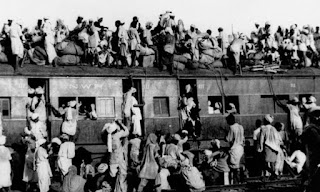Railways were introduced in india in 1850
 | |||||
| . |
Commencement of Railways. —The first railway line in India covering 34 kms. between Boribunder (Bombay) and Thana was opened to traffic on 16th April, 1853, barely 28years after the World's first train roads its initial successful run between Stockton and Darlington in England in 1825.
EVOLUTION OF INDIAN RAILWAYS—HISTORICAL BACKGROUND
The first railway line in India covering 34 kms. between Boribunder (Bombay) and Thana was opened to traffic on 16th April, 1853, barely 28years after the World's first train roads its initial successful run between Stockton and Darlington in England in 1825. Within a year the line was extended to Kalyan. This marked the culmination of a process started ton years earlier when the idea of a railway to connect Bombay with Thana and beyond was first conceived by the then Chief Engineer under Bombay Government in 1843.
This idea took a concrete shape when a new company was formed in England under the name of the great Indian Peninsula Railway Company which was incorporated in England by an Act of Parliament or 1st August, 1849. The Railway Company entered into a contract on 17th August, 1849 with the East India Company according to which the Railway Company would inter alia raise a capital of £ 500,000.
The construction of the line from Bombay to Kalyan was started on 31st October 1850. The fine upto Thana was commissioned on 16th April, 1853 and upto Kalyan on hi May, 1854.
The Eastern sector, the first passenger train steamed out of Howrah station destined for Hooghly, 39 kilometers away, en (5th August, 1854. The railway line was extended upto Pundooah (61 kms. from Howrah) on 1st September, 1854 an4 on 3rd February, I8S5 the line was opened upto Raniganj.
In the South, the first railway line was opened on 1st July, 1856 between Veyasarpaudy and Walajah Road (Arcot), a distance of 101 kilometers. In the North a length of 19Z kilometers of railway line was from Allahabad to Kanpur on 3rd March, 1859, and 3 years later the Amritsar-Atari section of Amritsar-Lanore fine was opened to traffic.
The section from Hataras Road to Mathura Cantonment was opened to traffic on 19th October, 1875 to be followed by the section from Kanpur to Farukhabad in the winter 1880-81.
 | |||||||||
| Locomotive Engine No. 2, 1875 | Date: 1875 | Media: pen and ink and wash on paper | Size: 266 x 425 mm | Acquired:1964; Gift | Accession Number: 64.257 |
When India’s first commercial passenger train pulled out of Bori Bunder station in Bombay in 1853, it travelled only 34 kilometres in an hour and a half. Less than 50 years later, there were 41,000 km of railway lines across the country, administered by 33 different railway companies, only four of which were run by the state.
Early Railway Companies.—The first railways built in India were constructed and worked by private sterling companies who were guaranteed a fixed rate of exchange and a specified return on the capital invested by them.
During 1854-40, contracts for the construction of railways in India were made by the East India Company or (after 1858) by the Secretary of State for India, with the East Indian Railways Company, the Great Indian Peninsula Railway Company, the Madras Railway Company, the Bombay Baroda and Central India Railway Company, the Sind (afterwards the Sind, Punjab and Delhi) Railway Company, the Eastern Bengal Railway Company, the Great Southern of India (afterwards the South Indian) Railway Company and the Calcutta and South Eastern Railway Company.
Name of Railway Date of taking Over by Government
I) The East Indian Railway .. .. .. 1st January ,1925
(2) The Great Indian Peninsula Railway .. 1st July, 1925
(3) The Bombay Boroda and Central India Railway 1st January, 1942
(4) The Assam Bangal Railway .. .. 1st January, 1942
(5) Oudh and Tirhut Railway .. .. ,. 1st January, 1943
(6) The Madras and Southern Maharastra Railway .. 1st April, 1944
(7) The South Indian Railway .. .. .. 1st April 1944,.
(8) The Bengal Nagpur Railway .. .. .. 1st October 1944






















No comments:
Post a Comment